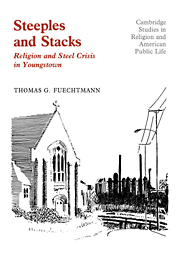Book contents
- Frontmatter
- Contents
- List of Tables and Figures
- Acknowledgments
- Introduction
- I Steeltown
- II The Industry
- III Shutdown
- IV Coping with Crisis: Community Response to the Shutdown
- V Religion and Urban Economic Crisis
- VI Launching a Movement
- VII The Plan
- VIII Negotiations
- IX Ending, Learning, Beginning Anew
- X Epilogue
- Notes
- References
- Index
VI - Launching a Movement
Published online by Cambridge University Press: 29 March 2010
- Frontmatter
- Contents
- List of Tables and Figures
- Acknowledgments
- Introduction
- I Steeltown
- II The Industry
- III Shutdown
- IV Coping with Crisis: Community Response to the Shutdown
- V Religion and Urban Economic Crisis
- VI Launching a Movement
- VII The Plan
- VIII Negotiations
- IX Ending, Learning, Beginning Anew
- X Epilogue
- Notes
- References
- Index
Summary
Bert Campbell, associate pastor of First Presbyterian Church and key member of the Coalition Steering Committee, was often asked, “What is the Ecumenical Coalition?” That question, he says, admitted a variety of answers. Sometimes the Coalition was simply the four members of the Steering Committee. Sometimes it was the whole organization: Executive and Steering Committees with the paid and volunteer staff. Again it might mean the entire organizational response of church and temple – at local, regional, and national levels. Or it might include all the people and organizations, both in Youngstown and across the country, who had provided some measurable support.
What was the Ecumenical Coalition?
The Double Agenda
At first, the Coalition was an emergent group. Two rather different dynamics contributed to its emergence. One was the dynamic of crisis response in the local community. The second was a recently sharpened sense of sociopolitical urban mission within the religious sector. Together, these two dynamics help explain how the Coalition came to be.
There is little or no evidence that the religious leaders who formed the Coalition's Executive Committee originally intended the Coalition to be anything more than an emergency crisismanagement group. They were busy people; this project would mean extra work on top of already full schedules. They had the political sense to realize that stepping beyond their traditional roles in church administration would be controversial; they might well antagonize some church members who preferred that priests and preachers stay out of business and politics.
- Type
- Chapter
- Information
- Steeples and StacksReligion and Steel Crisis in Youngstown, Ohio, pp. 146 - 198Publisher: Cambridge University PressPrint publication year: 1989

